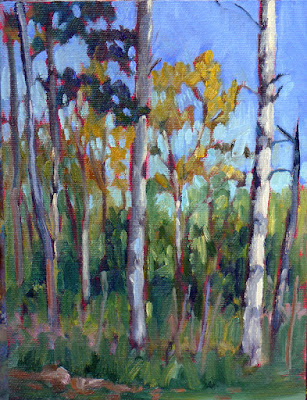The Jersey shore is hot, but I just remembered Big Boy tomatoes. Ah, bliss.
 |
| Beach Haven, by Carol L. Douglas |
Yesterday was more comfortable than Tuesday. It was still in the mid-eighties, but the humidity was lower and there was a slight offshore breeze.
Bobbi and I perched in a pavilion on Pearl Avenue at
Beach Haven. There’s an awesome orange water tower there, but no shade from which to paint it. We chose the beach for the pavilion.
We had considered getting a pedicure during the heat of the day, but decided that was irresponsible. Had we been working in Maine at these temperatures, we would have had ourselves declared dead and gone out for a wine spritzer. But we’re here to work, I kept reminding myself.
Periodically, guys ran down to the beach carrying a brace of brass bells. They rang them in long peals. I finally figured out that they were ice cream truck drivers, and that the bells were to advertise their wares. Business seemed slow to me.
“Usually, they rush over when I ring the bell, but it’s a little chilly today,” one of them said.
 |
| View from Joan’s rooftop aerie. |
My favorite place to paint thus far has been on the roof of a three-story house. In the real world, this would be a two-story house, but it’s up on stilts to avoid being flooded out. The space below has a man cave, an open-air studio and two outside showers. We should have worked down there, but one glimpse of the rooftop and I was hooked.
If I started shortly after dawn, I could work up there until mid-morning. The roof deck is painted with a thick white waterproof enamel that feels like the surround of a municipal swimming pool. It’s comfortable until it heats up. After that, it’s suddenly too hot to stand. I had no shoes on, of course. When it got to that point, I hopped around trying to clean up and get off the roof as quickly as I could.
Ironically, the major furnishing of this beautiful aerie is a hot tub.
There are too many paintings up there to ignore. While I’m painting the view between two houses, Bobbi is painting a street in the opposite direction. There are entire lives to be glimpsed from the roof: furniture, cars, the beach groomers, utility guys, cleaning people. It’s quiet and aloof, considering the crowds elsewhere.
I love being up there above the trees. I am the Little King of Everything, surveying all that I see.
 |
| Commercial scallopers, by Carol L. Douglas |
Our hostess is
Joan Gantz, a talented abstract painter. She just finished a mammoth mosaic mural project that has taken three seasons to complete. I don’t think I’ve ever been billeted in an artist’s house before. It’s been fun to talk art with her, and her studio makes a great place to stash our incomplete paintings.
New Jersey is the Garden State in part because it’s so hot. Joan reminded me about New Jersey tomatoes. I wonder if I can find room for an eight-quart basket of Big Boys in our already-overfilled car.

























